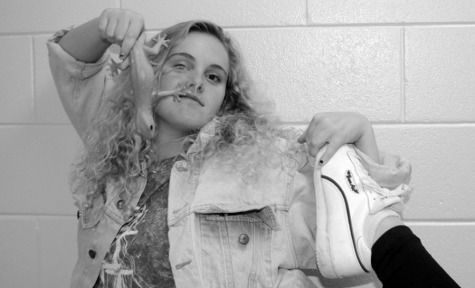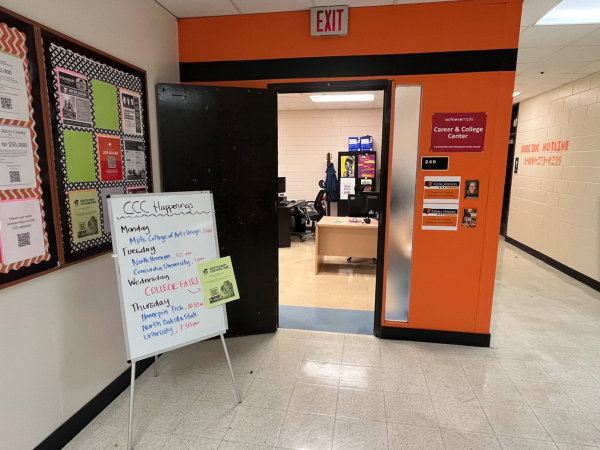Prescription drug abuse worsens with lack of education
December 19, 2013
She woke up again at 1:30 AM still feeling disoriented. Something was very wrong. Before she knew it she was looking over the edge on the roof of her seven-story condo building, her vision swimming and the option of escape there.
“I noticed there was a sign that said if you go beyond this fence its a $250 dollar fine, and I remember thinking ‘I wonder if my mom is going to have to pay that if I jump,’” said junior Clara Wildenauer. “The option was there. It was seven stories up so that ending, death, was possible.”
Earlier, after school that day, Wildenauer bought and consumed what she thought was Adderall near the bike racks outside of school before being picked up by her mom. In the car ride home she began to feel confused and started to zone out. Later, feelings of drowsiness and dizziness took over.
“I had finally figured out what I had took wasn’t what I had thought I took,” Wildenauer remembered. “It led me to realize I had a disregard for my own health. It was scary. I didn’t trust myself to make decisions.”
What Wildenauer thought was Adderall turned out to be Restoril, which the FDA defines as a sedative-hypnotic medicine used for the short term treatment of insomnia.
She explained that, “I had taken enough Restoril to knock a grown man out.”
“That’s why it’s risky to take these stimulants,” explained Anne Gorton, South’s Chemical Health Counselor.
“When a kid takes unprescribed medication they don’t usually get caught until they’re in big trouble. You can smoke weed and get caught which is bad but at least you’re not overdosing.”
Wildenauer’s Adderall use had gone on consequence-free since her first time trying it during sophomore year. Her use quickly escalated and went on unnoticed until she found herself on that roof.
“I was at the crossroads of ‘do I call my dad and get help or do I take the easy way out which was not dealing with it and jumping?’” Wildenauer explained.
“I started thinking about the other people in my life and then that’s when I decided I should call my dad.”
Luckily, he answered the phone and rushed to pick her up. Wildenauer was checked into Abbott Northwestern Hospital at 3:00 a.m., where she waited in the emergency room until a urine test could tell them what exactly she had ingested.
The abuse of prescription drugs has become increasingly common with an average of one in four U.S. high school students admitting to abuse or misuse according to a recent study done by the Metlife foundation.
Many think the use of prescription drugs is safer than using illegal drugs. This common misconception that the regulation of prescription drugs makes them safe does not mean that use is anywhere close to risk-free.
Mike (not his real name), a senior who uses both Adderall and marijuana illegally, believes that prescription drugs are generally safer than illegal drugs.
“Weed screws with my abilities and makes my lungs worse. I don’t know much about what Adderall does to my body but I’ve had no negative health impacts.”
Although stimulant use may seem harmless to health, they can cause “dangerously high body temperatures, possible feelings of hostility and paranoia, and the potential for heart failure or seizures,” according to the National Institute on Drug Abuse (NIDA).
NIDA also states that stimulants like Adderall are controlled substances and becoming dependent on them is not uncommon.
“I think there’s an attitude that [abusing prescription drugs] is pretty harmless because they’re made in a factory and come from the doctor,” explained Gorton.
The fact that stimulants such as Adderall, Ritalin, and Dexedrine are often associated with aiding academic achievement has also increased their illegal usage and often made the benefits of abuse seem greater than the risks. Both Wildenauer and Mike agreed that these positive academic impacts, combined with pressure to succeed in school, have compelled them to take Adderall.
Wildenauer’s decision take Adderall was partially due to the apparent positive academic impact associated with its use.
“The way people talk and think about it as a medication used for academics doesn’t make it seem as dangerous,” Wildenauer she explained. “I did get a lot of work done.”
The pressure to succeed in school has led Mike to continue his use of Adderall. “Before I took Adderall I wouldn’t do my homework in advance. Now I’m focused and more willing to do work.”
“The pills aren’t very expensive and I did it almost every day,” said Wildenauer. “I didn’t understand that I’m small and often I would take too much. I didn’t know I was forming a habit.”
Mike explained he doesn’t feel a need to stop his use in the future. “It’s cheap and enjoyable. It just makes the day better so I don’t think I’ll stop.”
Although the use of stimulants is seen as less harmful than illegal drugs, tobacco, or alcohol the consequences for students remain the same.
South High’s Student Handbook states, “Students may not have in their possession, use or be under the influence of alcohol, tobacco or other chemicals not prescribed by their healthcare provider while at school or at school functions.”
At South, the best-case scenario for students caught misusing prescription drugs is suspension, while complete removal from school is not uncommon.
They must also be referred to the police liaison, with the legal consequences of a misdemeanor, up to a $1,000 fine, and at worst, a one-year sentence.
Although Wildenauer didn’t face any legal consequences, her time at Abbott taught her about those and many other possible repercussions.
“The idea of being in a psych ward is hard to get through your head sometimes, but they were really good at supporting you,” she explained. “I understood the risks more because we talked about how drugs interact with each other. I’m not a doctor and I just don’t know how things interact.”
Now Wildenauer has both a therapist and a psychiatrist and has been officially prescribed a different ADHD medication and a stabilizer.
She has also found that singing has aided her therapy process. “I had gotten disconnected from music before going to Abbott which is a big part of how I find purpose in life now,” Wildenauer stated. “I’ve been feeling a lot more connected to that part of myself which is pretty important.”
Wildenauer noted that something disconcerting throughout her experience was the lack of education surrounding prescription drug abuse.
“I definitely feel like in the health courses I’ve taken there’s an entire unit on alcohol. I don’t even think prescription drugs were barely mentioned at all. If people had been talking to me about it more I feel like it wouldn’t have been so easy for me to self-medicate.”
The lack of education surrounding prescription drug abuse is startling. In fact, it causes the largest percentage of deaths in drug overdosing.
“Prescription drug abuse isn’t being taken as seriously as it should be,” Gorton said. “There are lots of campaigns to wear a seatbelt and to not drink and drive. I think more education about it would be awesome.”
Wildenauer believes that no matter who you are, caution should always be taken when it comes to putting something into your system.
“The fact that I was ingesting these things that have a very powerful effect on your health and there wasn’t thought or investigation was scary.”
She advises people taking or considering taking prescription drugs illegally to be informed. “There are so many ways for people to screw you over. People should be careful about what they put in their system.”












